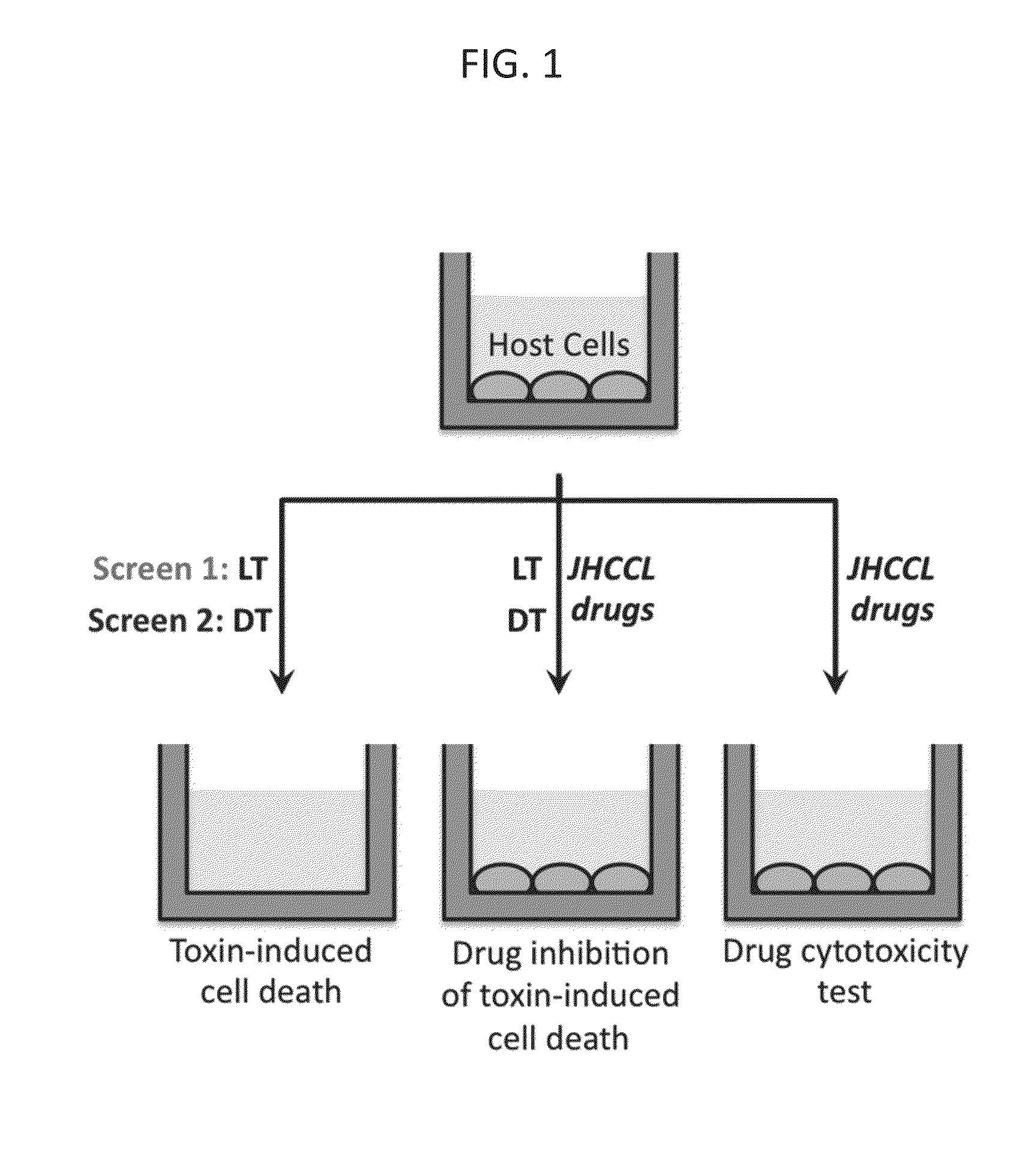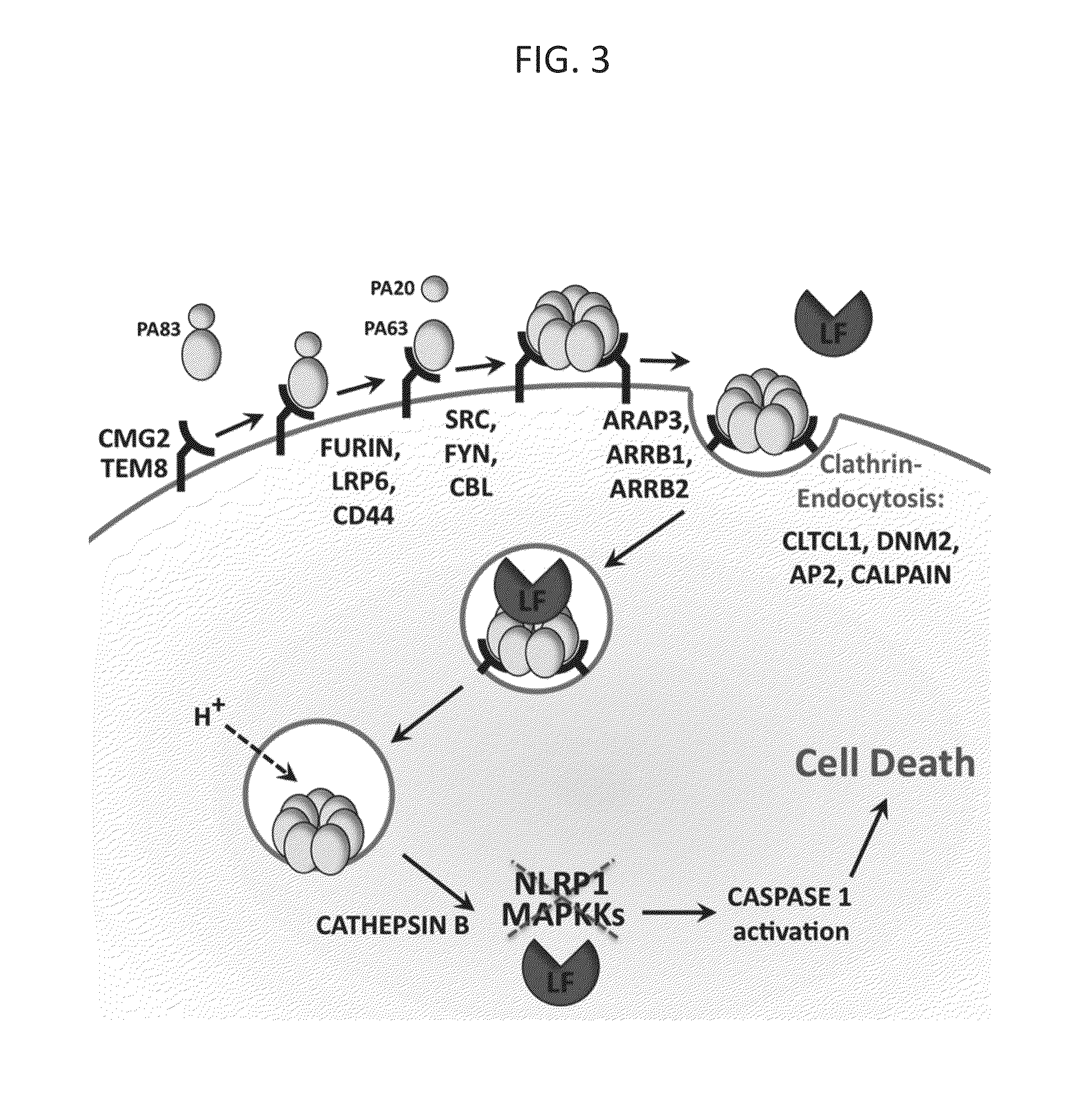Compositions and methods for inhibiting bacterial and viral pathogens
a technology of bacterial and viral pathogens, which is applied in the direction of antibacterial agents, biocide, heterocyclic compound active ingredients, etc., can solve the problems of toxins that damage the host cell
- Summary
- Abstract
- Description
- Claims
- Application Information
AI Technical Summary
Benefits of technology
Problems solved by technology
Method used
Image
Examples
example 1
[0069]Screening of FDA approved drugs for inhibitors of toxin-induced cell death. In a systematic effort to identify candidates for repurposing drugs as broad-spectrum, host-oriented, anti-toxin countermeasures, the Johns Hopkins Clinical Compound Library (JHCCL) of 1,581 agents (agents previously approved as drugs by the U.S. Food and Drug Administration) were screened for the ability to reduce lethality of RAW264.7 and C32 cells treated either with Bacillus anthracis lethal toxin or diphtheria toxin (FIG. 1). These toxins were chosen because the mechanisms underlying their pathogenicity are well understood and are disparate to each other.
[0070]Between 50 and 70 percent of cells used for these assays normally undergo cell death, as determined by MTT (3-(4,5-dimethylthiazol-2-yl)-2,5-diphenyltetrazolium bromide) assay, within 6 and / or 24 hours of exposure to anthrax lethal toxin and diphtheria toxin respectively, under the experimental conditions employed. A “hit” in this screen was...
example 2
[0073]Amodiaquine and its metabolite are potent inhibitors of LF-PA induced death in vitro and in vivo. After oral administration, AQ is rapidly absorbed and undergoes fast and extensive metabolisation by hepatocytes' cytochrome p450 enzyme to the AQ metabolite, Desethyl-Amodiaquine (DEAQ), the main active metabolite of AQ. The ability of DEAQ to reduce anthrax toxin mediated cellular killing was tested, and it was observed that just like AQ, DEAQ was able to reduce toxin-mediated cytotoxicity with an EC50 of 5 μM (FIG. 6A). Since AQ and its metabolite, DEAQ, protected host cells against anthrax toxin killing, the efficacy of AQ was evaluated as a therapeutic agent during anthrax toxin intoxication in Sprague-Dawley rats. Animals were injected intravenously with a lethal dose of anthrax toxin (LD100) and were intravenously co-injected with AQ at 1.5, 3.0, or 6.0 mg / kg. The AQ doses were selected based on the FDA approved AQ dose of 10 mg / kg. Animals that received a lethal dose of an...
example 3
[0074]Amodiaquine Inhibits Cytosolic Entry of LF. In order to identify the step at which AQ inhibits LF-PA-mediated lethality, the processes that mediate the cellular entry of this toxin and toxin-induced pyroptosis were assessed in the presence and in the absence of AQ. Caspase-1 activation, which occurs late in LF-PA intoxication, was monitored using a fluorescent probe, FLICA. This probe specifically binds to active caspase-1. While high levels of caspase-1 activity were observed upon LF-PA treatment in the absence of AQ, active caspase-1 was not detected in AQ-treated cells that were challenged with anthrax toxin (FIG. 8). This result shows that AQ inhibits cytotoxicity upstream of caspase-1 activation.
[0075]Activation of caspase-1 by LF is a late step in pyroptosis, and depends on LF catalytic activity. To determine whether AQ blocks proteolysis of cellular MAPKKs by LF, the cleavage of MEK2 by immunoblotting was assessed. While MEK2 was cleaved in LF-PA treated RAW264.7 cells,...
PUM
| Property | Measurement | Unit |
|---|---|---|
| concentrations | aaaaa | aaaaa |
| pH | aaaaa | aaaaa |
| concentrations | aaaaa | aaaaa |
Abstract
Description
Claims
Application Information
 Login to View More
Login to View More - R&D Engineer
- R&D Manager
- IP Professional
- Industry Leading Data Capabilities
- Powerful AI technology
- Patent DNA Extraction
Browse by: Latest US Patents, China's latest patents, Technical Efficacy Thesaurus, Application Domain, Technology Topic, Popular Technical Reports.
© 2024 PatSnap. All rights reserved.Legal|Privacy policy|Modern Slavery Act Transparency Statement|Sitemap|About US| Contact US: help@patsnap.com










